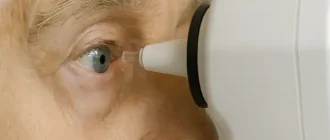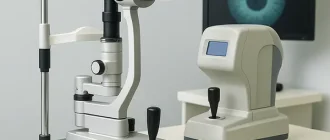Waking up with pressure behind your eyes can be disorienting and even concerning. Whether it’s a dull ache or a more intense pressure, this symptom can disrupt your morning routine and leave you searching for answers. While occasional discomfort might be easily dismissed, recurring pressure behind the eyes could indicate underlying health issues. Let’s delve deeper into the possible causes, symptoms to watch out for, and the steps you can take to alleviate this pressure.
Common Causes of Eye Pressure After Sleep

Pressure behind the eyes after sleep can arise from several sources, ranging from eye-related conditions to systemic health issues. Here are some of the more common causes:
1. Sinus Congestion
The sinuses are located near the eyes, and when they become congested, the buildup of pressure can transfer to the area behind the eyes. Sinusitis, a common condition characterized by inflamed sinuses, can lead to this type of discomfort, especially in the morning when fluid tends to accumulate overnight.
| Symptom | Characteristics |
|---|---|
| Sinus-related eye pressure | Worse when bending over or lying down |
| Nasal congestion | Often accompanied by a stuffy nose |
| Sinus headache | Dull ache around forehead and eyes |
2. Dry Eyes
Sleep environments, especially with low humidity or exposure to fans and air conditioning, can exacerbate dry eyes. Overnight, the eyes may not get sufficient lubrication, leading to discomfort and pressure after waking up.
3. Eye Strain or Fatigue
In today’s digital world, prolonged screen time and poor sleep hygiene can result in eye strain. Overworked eye muscles may not fully relax during sleep, causing tension and a sensation of pressure upon waking.
4. Glaucoma
Glaucoma is a more serious concern. This condition occurs when fluid buildup increases intraocular pressure. In some cases, individuals may experience heightened symptoms, such as eye pressure or discomfort, after a night’s rest, particularly if fluid drainage is impaired.
| Glaucoma Type | Key Symptoms |
|---|---|
| Open-angle glaucoma | Gradual vision loss, slight pressure |
| Angle-closure glaucoma | Sudden eye pain, nausea, blurred vision |
5. Migraine or Cluster Headaches
Migraines and cluster headaches often involve pressure or pain around the eyes. While these headaches are more commonly associated with throbbing pain, they can also lead to sensations of pressure behind the eyes, particularly in the early morning hours.
Patient Cases: Real Experiences of Eye Pressure After Sleep
Case 1: Sarah’s Sinus Struggles
Sarah, a 32-year-old teacher, began noticing a dull pressure behind her eyes each morning. It felt as though her eyes were swollen from the inside, often making it difficult to focus. After several weeks, she visited her doctor, who diagnosed her with chronic sinusitis. Sarah’s relief came through a combination of nasal sprays, steam inhalation, and addressing her home’s dry air with a humidifier. Within two weeks, her eye pressure reduced significantly.
Case 2: John’s Digital Dilemma
John, a software developer in his mid-40s, started experiencing pressure behind his eyes when waking up after long days at the office. He initially thought it was just sleep deprivation, but the pressure persisted. A visit to an ophthalmologist revealed that his eye strain was linked to extended screen time. After adjusting his screen habits and incorporating regular breaks, the morning pressure behind his eyes disappeared.
Case 3: Maria’s Glaucoma Discovery
Maria, a 60-year-old retiree, had been managing her health well but noticed persistent pressure behind her eyes every morning. This pressure was different – it felt deeper, more intense. After a comprehensive eye exam, her ophthalmologist diagnosed her with early-stage glaucoma. Thanks to early intervention with medication and regular monitoring, Maria’s eye pressure is now under control, and she remains vigilant about her eye health.
Addressing the Pressure: Diagnosis and Treatment
To accurately diagnose the cause of pressure behind the eyes, a thorough examination by a healthcare professional is crucial. Here are common diagnostic approaches:
1. Eye Exam
A detailed eye exam will help rule out conditions like glaucoma or dry eye syndrome. Tonometry, a test that measures intraocular pressure, is often used to check for glaucoma.
2. Sinus Evaluation
If sinus congestion is suspected, imaging studies like a CT scan can assess the severity of sinusitis or other sinus-related conditions.
3. Lifestyle Assessment
Doctors may ask about screen time, sleep habits, and any environmental factors that could be affecting eye health. Eye strain or poor sleep posture can often contribute to the sensation of pressure behind the eyes.
Treatment Options for Eye Pressure After Sleep
Depending on the underlying cause, treatment may vary. However, some general recommendations can provide relief:
- For Sinus Congestion: Use decongestants, saline nasal sprays, or humidifiers to reduce sinus pressure.
- For Dry Eyes: Apply artificial tears or invest in a humidifier to maintain moisture levels around the eyes.
- For Eye Strain: Follow the 20-20-20 rule (every 20 minutes, look at something 20 feet away for 20 seconds) and consider adjusting screen brightness.
- For Glaucoma: Follow your doctor’s prescribed regimen, which may include medicated eye drops to reduce intraocular pressure.
- For Migraines: Consult with a specialist for migraine management strategies, which may involve medications or lifestyle changes.
Statistics and Final Thoughts
According to the National Eye Institute, approximately 2.7 million Americans suffer from open-angle glaucoma, with many being unaware until it progresses. Additionally, dry eyes affect nearly 16 million people in the U.S., often exacerbated by modern lifestyles.
For those waking up with pressure behind their eyes, it’s essential to understand that while it may be a minor inconvenience for some, it can also be an early indicator of more significant issues. Paying attention to your symptoms, seeking professional advice, and taking preventative measures can make all the difference in maintaining long-term eye health.
By understanding the causes and seeking the right treatment, you can relieve that uncomfortable morning pressure and get back to starting your day with clear, healthy eyes.





